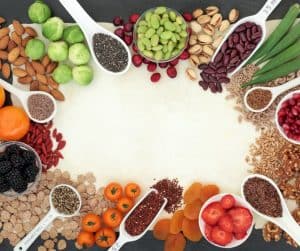
Endometriosis is a painful condition impacting over 830,000 Australian women and girls and over 176 million women worldwide. With endometriosis, inflammation and estrogen dominance impacts tissue similar to the uterine lining and encourage growth in other areas of the body outside the womb such as in the pelvic cavity, the ovaries, fallopian tubes, intestines, or bowel.
Treatment commonly consists of medical and surgical therapies to remove the endometrial-like tissue. Painkillers and hormonal treatments are frequently offered to sufferers, but unfortunately, up to 50% of women will experience a recurrence of symptoms within 5 years (2). Many find the years before diagnosis extremely frustrating as they seek validation for their symptoms.
The exact causes of endometriosis remain unknown, however, family history, retrograde menstruation, metaplasia (conversion of normal pelvic tissue into endometriosis), alcohol intake, and early onset of periods (prior to 11 years of age) may play a role.
A third of women will be diagnosed after being unable to fall pregnant or inadvertently during an operation.
10 symptoms of endometriosis:
Athletes and endometriosis
Endometriosis impacts athletes at all levels. Olympian Elinor Baker along with many women in sport are working to improve the awareness of endometriosis in sports. If you suffer from this condition it’s likely you may be able to relate to Elinor’s painful symptoms “as though someone was ringing out my organs as if they were a tea towel”. The fatigue, pain and heavy bleeding can severely impact athletes and their ability to compete and train. It is not uncommon for athletes to miss competitions due to surgeries, muscle cramps, and debilitating pain.
Natural treatment options
Our understanding of endometriosis is deepening, and holistic treatment approaches are showing promising results. Symptom reduction and improvements in quality of life have been demonstrated through food first and a targeted treatment approach including herbal and nutritional medicines.
By reducing underlying inflammation, improving the immune response, and clearing excess estrogen, women can reduce the severity of symptoms, scarring, and formation of endometrium growths.
Dietary interventions alone have reported reductions in painful symptoms and bowel complaints in up to 75% of women. Increased consumption of essential fatty acids, antioxidants, and a combination of vitamins and minerals have also been shown to have positive effects on endometriosis-associated symptoms. Other nutraceuticals such as resveratrol may improve endothelial wound healing while phytochemicals such as Diindolylmethane (DIM) or calcium-D-glucarate may help support clearance of excess estrogen and relieve pain associated with periods in sufferers of endometriosis.
Our seed cycling blog describes the benefits of using seeds to maintain healthy hormones. purchase your seeds for your cycle here
It can be reassuring to know that with the right self-care and a holistic approach to health, you can continue to achieve life goals and sporting success. An early diagnosis and understanding of your condition may result in better management of your symptoms.
About the Author: Kate Smyth is a Sports naturopath, nutritionist and female-centric running coach. She is the founder of the Athlete Sanctuary- a holistic healthcare clinic for athletes of all levels and sporting codes. Kate has a thirst for knowledge with two bachelor’s and a master’s degree under her belt. She has been involved in sports for many decades and competed for Australia in the Commonwealth Games and Olympic Games marathons with a personal best time of 2 hours 28 minutes. For more information visit https://athletesanctuary.com.au/kate-smyth
References
Endometriosis in Australia: prevalence and hospitalizations. VIEW
Hickey M, Ballard K, Farquhar C. Endometriosis BMJ 2014; 348:g1752 doi:10.1136/BMJ.g1752
Hui, E., & Nap, A. (2020). The effects of nutrients on symptoms in women with endometriosis: a systematic review. Reproductive BioMedicine Online, 41(2), 317-328. https://www.sciencedirect.com/science/article/abs/pii/S147264832030225X
Marziali M, Venza M, Lazzaro S, et al. Gluten-free diet: a new strategy for management of painful endometriosis related symptoms? Minerva Chirurgica. 2012 Dec;67(6):499-504. http://europepmc.org/article/med/23334113
Moore, J. S., Gibson, P. R., Perry, R. E., & Burgell, R. E. (2017). Endometriosis in patients with irritable bowel syndrome: the specific symptomatic and demographic profile, and response to the low FODMAP diet. Australian and New Zealand Journal of Obstetrics and Gynaecology, 57(2), 201-205. https://obgyn.onlinelibrary.wiley.com/doi/abs/10.1111/ajo.12594
Jean Hailes www.jeanhailes.org.au
Oregon State University (2022).Resveratrol www.https://lpi.oregonstate.edu
Endometriosis Australia www.endometriosisaustralia.org
BBC Sport www.bbc.com/sport/56276626

Kate Smyth is a sports naturopath, nutritionist and female-centric running coach. She is the founder of the Athlete Sanctuary – a holistic healthcare clinic for athletes of all levels and sporting codes.
Kate has a thirst for knowledge, with two bachelor’s and a master’s degree under her belt. She has been involved in sports for many decades and competed for Australia in the Commonwealth Games and Olympic Games marathons with a personal best time of 2 hours 28 minutes.
Targeted naturopathic care, nutrition and holistic coaching for active individuals.
Normatec Recovery systems- hire and purchase
Birregurra -28-30 Strachan Street,
Torquay- 20 Cantala Drive, Jan Juc
TELEHEALTH – Aus wide, New Zealand, Canada and globally (except US)
Melbourne and Ballarat clinics are currently online